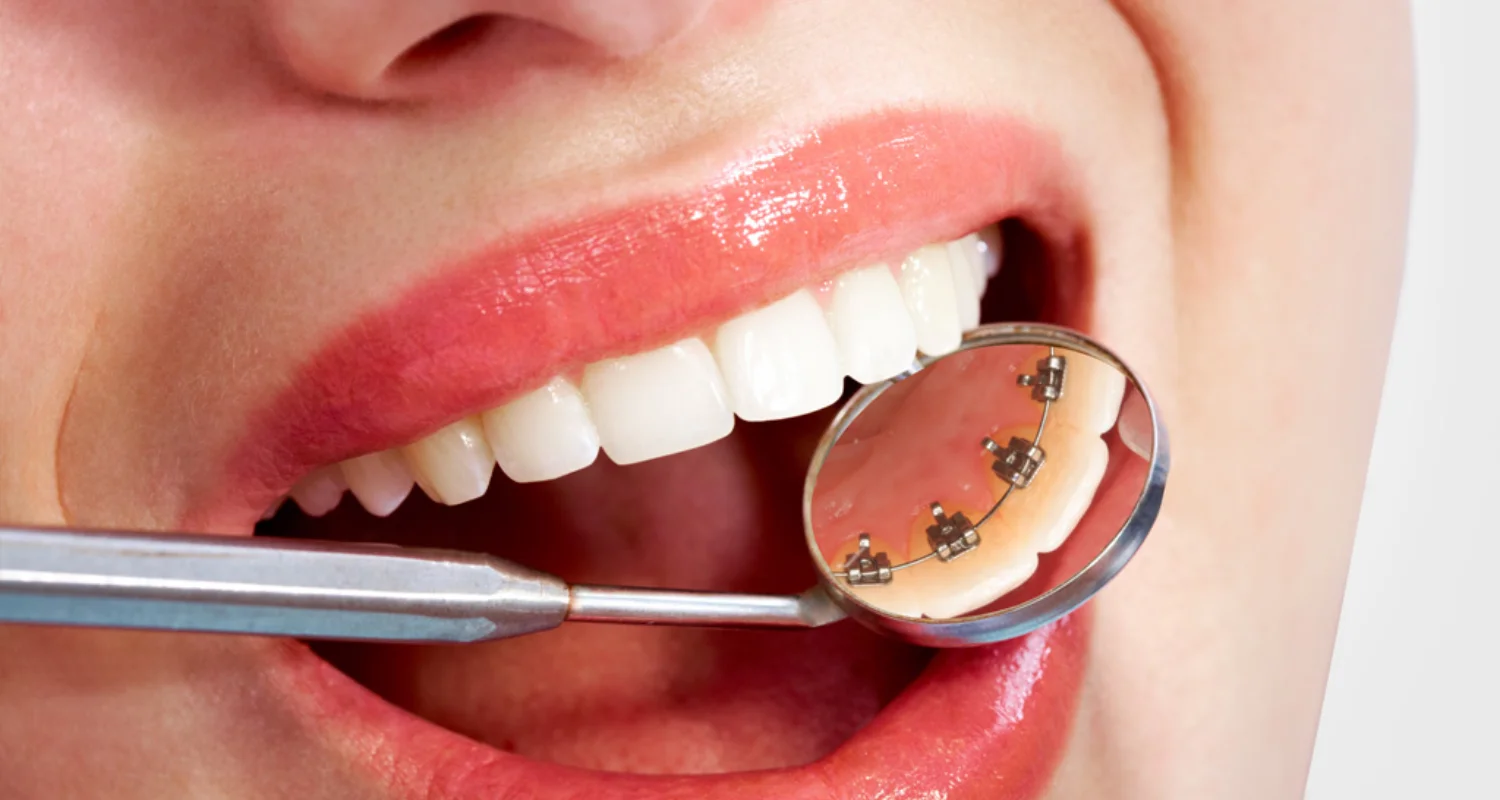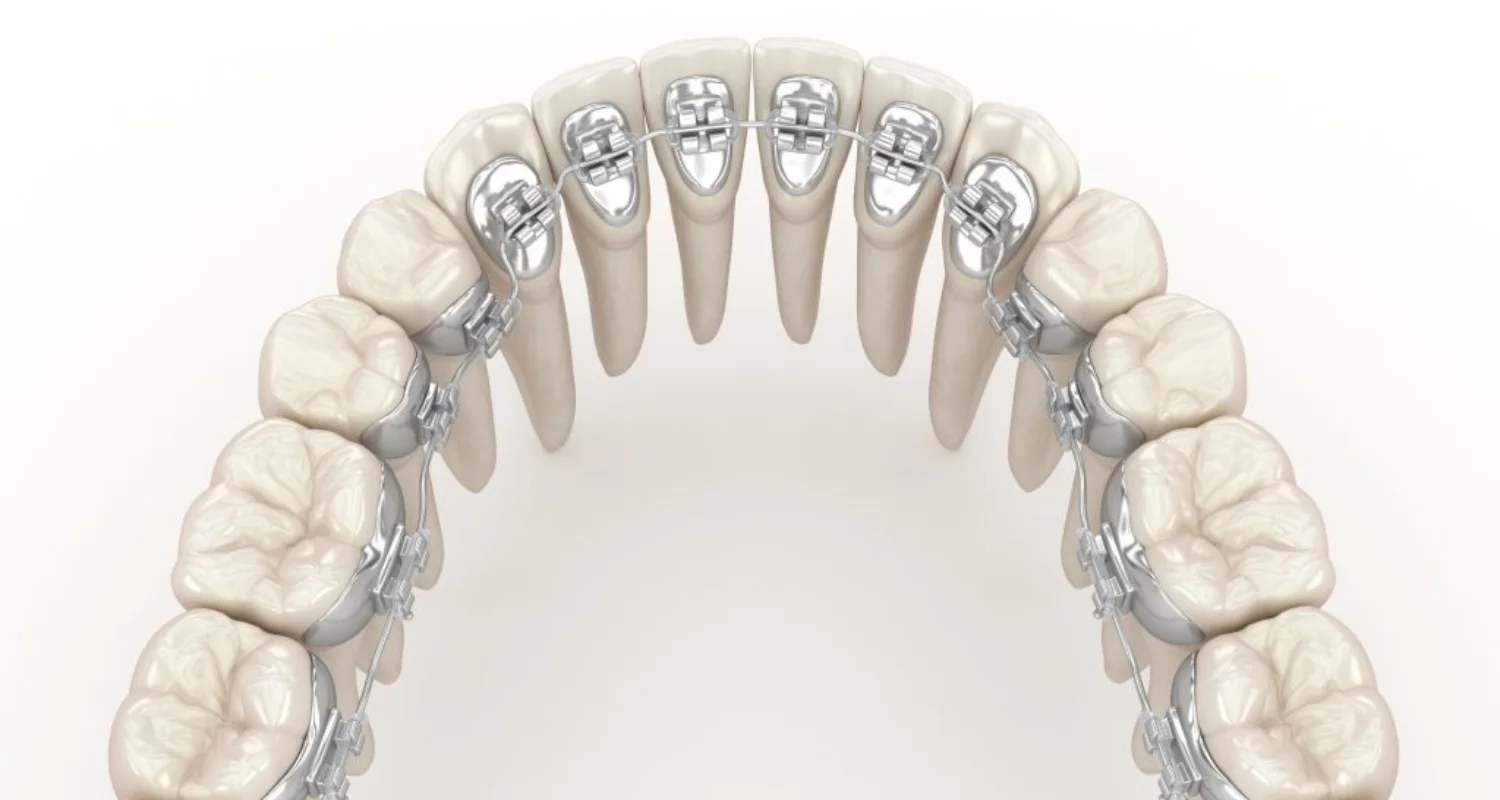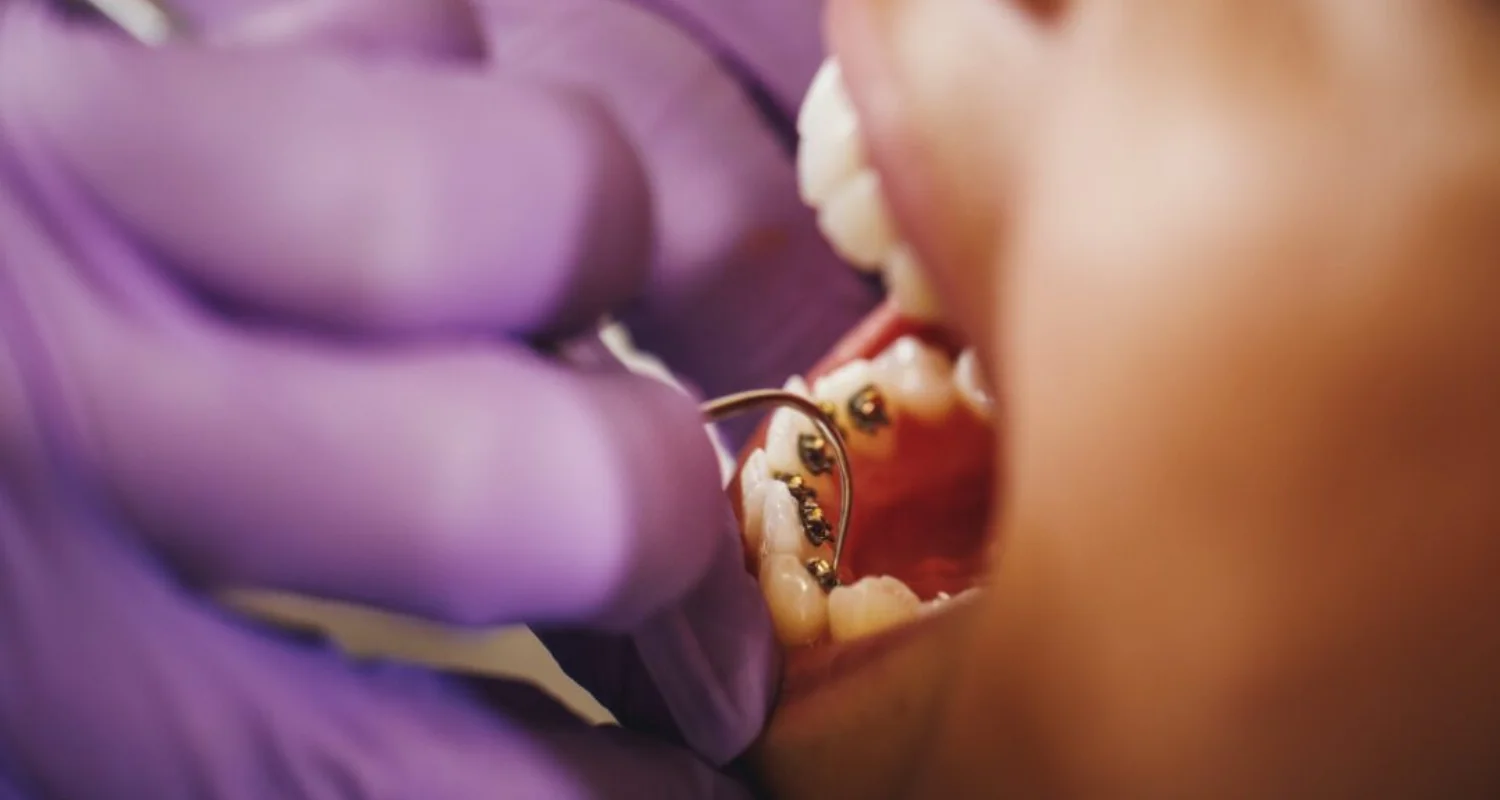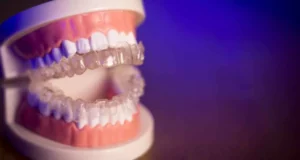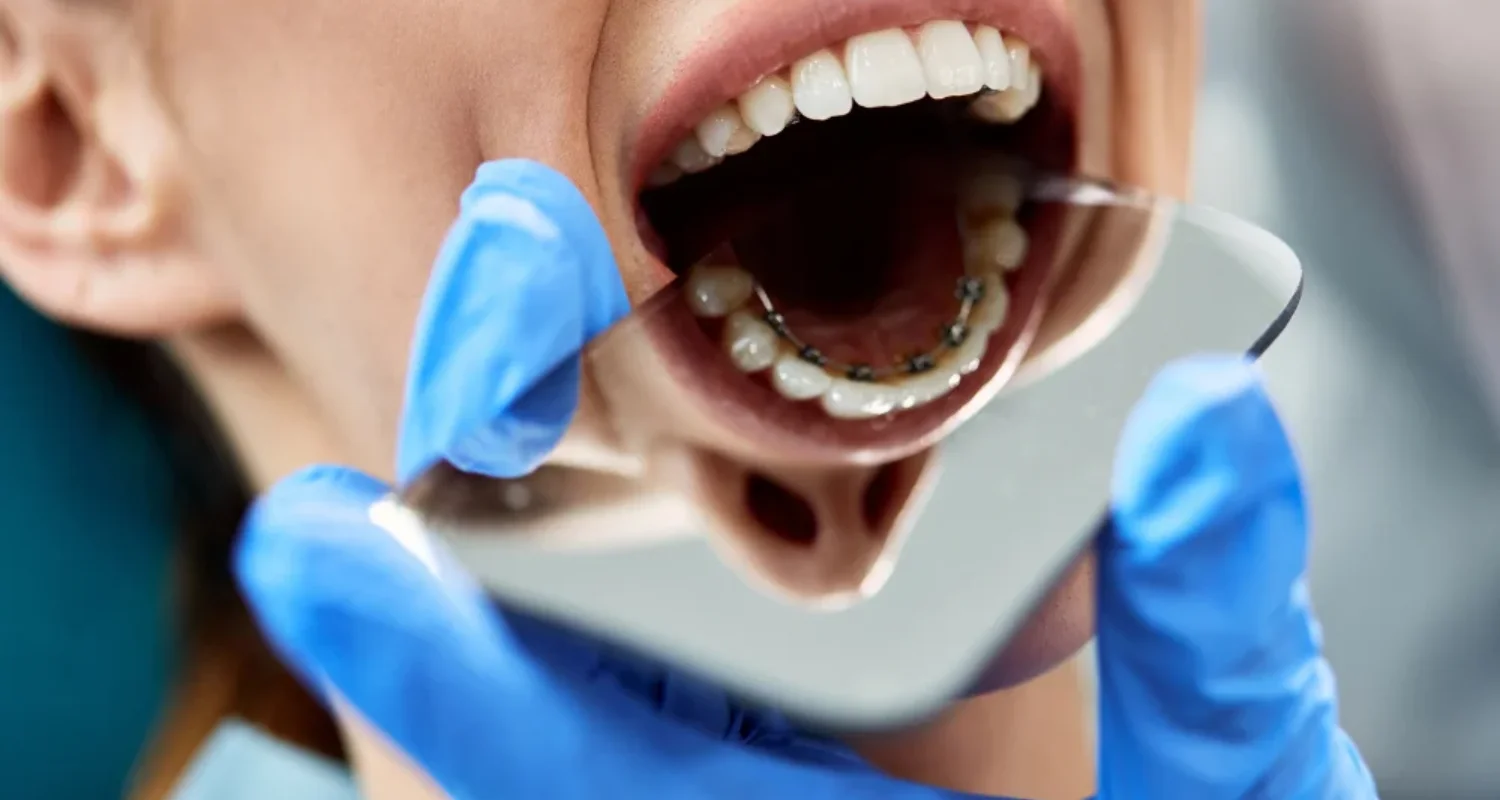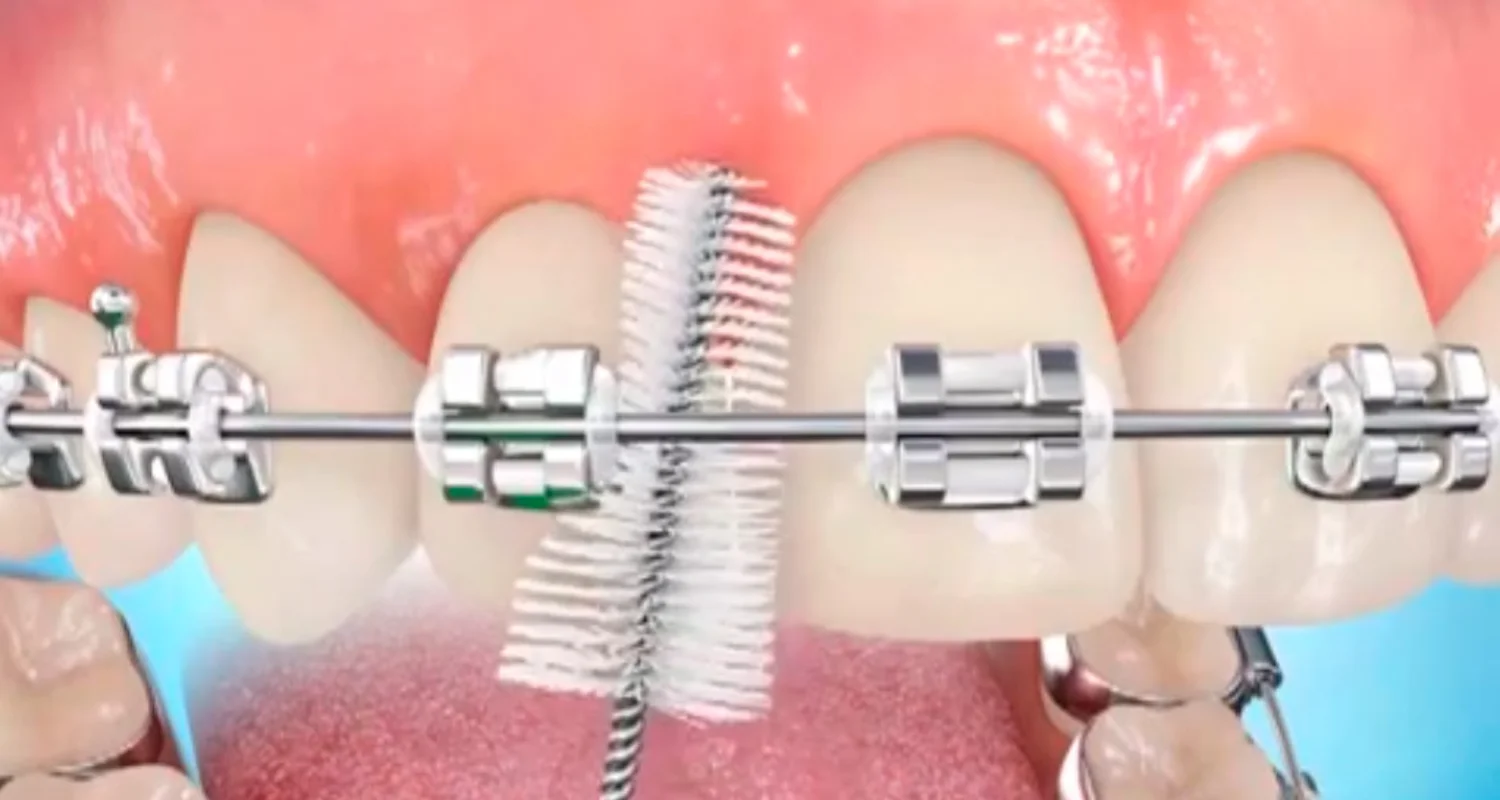Last Updated on: 20th December 2025, 07:39 am
Lingual braces are fixed behind the teeth to discreetly straighten your smile, offering aesthetic benefits ideal for adults and professionals. While effective for complex cases, they cost more, can affect speech initially, and require diligent oral hygiene.
Lingual braces are a modern orthodontic approach for those desiring aesthetic correction without braces that show. Unlike traditional braces placed on the front sides of the teeth, lingual braces are placed at the back of the teeth, making them invisible.
Through this unique design, patients can undergo orthodontic treatment without compromising their appearance, making it popular for adults and working professionals.
In this article, we explain how lingual braces work, their pros and cons, and how they compare with traditional braces. We also describe who makes a good candidate, helping you decide if this discreet orthodontic option suits your needs.
What are lingual braces?
Lingual braces are specialized orthodontic appliances designed to straighten and align teeth discreetly.
Unlike regular braces that are bonded on the front or labial side, lingual braces are bonded at the back side or lingual side of the teeth. Given that they are discreet, they are ideal for those who want to have their misalignment fixed without the stigma of typical braces.
The primary function of lingual braces is to provide the same orthodontic benefits as traditional braces, but in a more aesthetically pleasing way. They are largely in demand by adults, working professionals, and celebrities, especially in the fashion and movie industry, who would want a treatment that does not mar their physical appearance.
Do lingual braces have contraindications?
While effective for many orthodontic cases, these braces do have specific contraindications that can affect their suitability for certain patients.
- Irregular dental crown shapes: Morphological issues can complicate bracket placement and reduce effectiveness.
- Severe bite problems: Such as pronounced underbites or overbites, which can exert excessive pressure on brackets and risk damage.
- Poor oral hygiene: Difficulty maintaining cleanliness can lead to irritation, infection, or treatment complications.
- Health conditions affecting healing: Certain systemic or oral health issues may increase the risk of adverse outcomes during treatment.
In these cases, an orthodontist may recommend alternative treatments better suited to the patient’s dental and overall health.
What options exist for lingual braces?
There are two primary options for lingual braces: stock and customized.
- Stock braces are prefabricated and can be placed on models of the patient’s teeth by a laboratory, either commercial or in-clinic. After fabrication, these braces are transferred directly into the patient’s mouth.
- Customized lingual brackets, on the other hand, are designed digitally based on the specific treatment needs of the patient. Such customization allows for a more tailored fit and potentially more effective treatment outcomes.
What types of lingual braces are available?
Modern lingual braces come in three notable types:
- Incognito: These are fully customized brackets designed to fit each tooth precisely. They are known for their aesthetic appeal and effectiveness in treating complex cases.
- Suresmile: This system utilizes advanced digital technology to optimize tooth movement and treatment efficiency, providing a personalized approach to orthodontics.
- Aalias system: This type focuses on minimizing discomfort and maximizing treatment precision by using innovative bracket designs and materials.
Each of these systems offers unique advantages in terms of comfort, aesthetics, and effectiveness in achieving desired orthodontic results.
How exactly do lingual braces work?
Lingual braces work like regular orthodontic braces but are bonded to the back of the teeth, making them nearly invisible.
Normally, the treatment process includes:
- Impressions or digital scans: The orthodontist takes precise molds or 3D scans of the patient’s teeth.
- Bracket fabrication:
- Special brackets are custom-made to fit each tooth exactly.
- A special tray is used to cement them all at once, since there’s limited space for individual placement.
- Wire attachment: Custom wires are connected to the brackets to gently apply continuous pressure, gradually moving the teeth into the desired position.
- CAD-CAM customization: Brackets and wires are digitally designed for optimal fit, precision, and efficiency.
- Regular adjustments: Patients visit the orthodontist every 6–8 weeks for progress checks and wire modifications.
Custom-made lingual braces can make the treatment time faster and relatively comfortable, owing to the product’s slim nature.
How do lingual braces differ from traditional braces?
Although both types of braces are designed to align and straighten teeth effectively, they differ in several important ways.
How do they differ in positioning and appearance?
- Lingual braces: Attached to the back of the teeth, making them nearly invisible.
- Traditional braces: Placed on the front of the teeth, making them more noticeable.
This gives lingual braces a clear aesthetic advantage for those seeking discreet treatment.
How do they compare in comfort and adjustment?
- Lingual braces may cause initial tongue irritation and speech difficulties, which can persist for several weeks or even months.
- Traditional braces usually result in fewer speech issues, and most patients adjust within a week.
All types of braces may temporarily affect speech, but studies show lingual braces may alter speech for a month or more. The degree of change depends on the brand and design used. Some patients benefit from speech therapy, and speech typically returns to normal as the tongue adapts.
How do they differ in cost?
- Lingual braces: Around $8,000–$10,000, due to their high level of customization and specialized expertise.
- Traditional braces: Generally $3,000–$7,000.
Overall, lingual braces are the most discreet but also the most costly option among fixed orthodontic treatments.
Are lingual braces better than clear aligners?
There are key differences between lingual braces and clear aligners that will influence the decision on which treatment is best for each patient. Below is an organized comparison of their main characteristics.
What are the key differences?
- Lingual braces: Fixed appliances attached to the back of the teeth, making them virtually invisible and not removable.
- Clear aligners: Removable, custom-made devices made of transparent plastic. They must be worn 20–22 hours a day to be effective.
How do they compare in appearance?
- Lingual braces: Completely invisible from the front, though slightly bulky at first.
- Clear aligners: Nearly invisible but may be noticeable up close due to plastic shine or visible attachments.
Can they be removed?
- Lingual braces: Fixed in place 24/7, ensuring consistent progress.
- Clear aligners: Removable for eating and brushing, making oral hygiene easier but relying on patient discipline.
Which is more effective?
- Lingual braces: Highly effective for complex cases requiring significant tooth movement.
- Clear aligners: Better for mild to moderate misalignments.
What about cost?
- Lingual braces: Typically $8,000–$10,000 due to customization and expertise.
- Clear aligners: Usually $4,000–$8,000 depending on brand and complexity.
Both treatments have unique advantages; the choice depends on the patient’s needs, budget, and commitment.
Who is a good candidate for lingual braces?
Lingual braces are ideal for individuals seeking discreet orthodontic treatment. However, not everyone is a suitable candidate. Here are examples of ideal and non-ideal cases.
Who are ideal candidates?
- Adults and teens prioritizing discreet treatment.
- Patients with mild to moderate alignment issues.
- Individuals committed to maintenance and regular orthodontic visits.
Who may not be suitable?
- Those with severe bite issues.
- Patients with small teeth or limited enamel surface.
- Individuals with gum problems or enamel wear.
- Budget-sensitive individuals due to higher cost.
Consulting with an orthodontist is crucial to determine if lingual braces are appropriate.
What are the benefits and drawbacks of lingual braces?
Like any orthodontic treatment, lingual braces have both advantages and limitations.
What are the main benefits?
Invisibility
Lingual braces are mounted behind the teeth, hidden from view.
Less pain
Studies suggest lingual braces may cause less overall pain but more tongue irritation. Click here to purchase a product that protects your tongue.
Fewer lifestyle changes
Lingual braces require fewer adjustments to daily life compared to traditional braces.
Custom design
They can be tailored using CAD/CAM technology, improving comfort and speech outcomes.
What are the main drawbacks?
Limited orthodontist availability
Few orthodontists are trained in lingual techniques, making them harder to find.
Speech challenges
Speech can be temporarily affected but usually improves as the tongue adapts.
High cost
Lingual braces are more expensive, especially custom-made ones.
Oral hygiene challenges
Their placement makes cleaning harder. A water flosser can help maintain oral hygiene.
Longer appointments
Due to precise adjustments and custom archwires.
What is the final takeaway on lingual braces?
Lingual braces offer a discreet and effective orthodontic solution for those seeking alignment without compromising appearance.
While they have specific pros and cons, consulting with an experienced orthodontist is key to choosing the right treatment.
With proper care and commitment, lingual braces can help you achieve a beautifully aligned smile.
Frequently Asked Questions
How effective are lingual braces?
What are the advantages of choosing lingual braces over traditional braces?
Are lingual braces right for you?
What are the main drawbacks of lingual braces?
How do lingual braces compare to clear aligners?
Voice and Search (Q&A)
Do lingual braces hurt?
You might feel tongue soreness at first, but most people say the pain is mild and improves within a few weeks.
Are lingual braces hard to clean?
A bit. Since they’re on the back of the teeth, it helps to use a water flosser or interdental brush every day.
How long does it take to get used to lingual braces?
Most people adjust within a few weeks, and speech feels normal again after about a month.
Share
References
1. Ames, H. (2024, October 16). Lingual Braces: Comparison, Pros, Cons, Costs. NewMouth. https://www.newmouth.com/orthodontics/treatment/lingual-braces/
2. Auluck A. (2013). Lingual orthodontic treatment: what is the current evidence base?. Journal of orthodontics, 40 Suppl 1, S27–S33. https://doi.org/10.1179/1465313313Y.0000000073
3. Joy, S. R. (2019, June 17). Lingual Braces: The Upside and Downside of Braces on the Back Side. Healthline. https://www.healthline.com/health/lingual-braces-2
4. Napitu, A. (2024, November 13). What do Lingual Braces Cost? Learn About Incognito Braces Behind Teeth. Dentaly.org. https://www.dentaly.org/us/lingual-braces/
5. WebMD Editorial Contributor. (2023, April 27). What to know about lingual braces. WebMD. https://www.webmd.com/oral-health/what-to-know-about-lingual-braces
-
Nayibe Cubillos M. [Medical Reviewer]
Pharmaceutical Chemestry |Pharmaceutical Process Management | Pharmaceutical Care | Pharmaceutical Services Audit | Pharmaceutical Services Process Consulting | Content Project Manager | SEO Knowledge | Content Writer | Leadership | Scrum Master
View all posts
A healthcare writer with a solid background in pharmaceutical chemistry and a thorough understanding of Colombian regulatory processes and comprehensive sector management, she has significant experience coordinating and leading multidisciplina...



